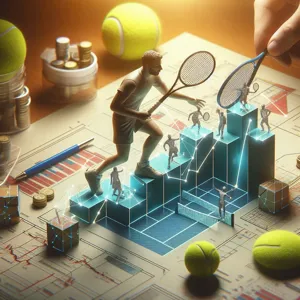Tennis is not just a game of strength and speed; it is a mental and physical battle that requires strategy, precision, and finesse.
Whether you’re a seasoned player looking to refine your technique or a beginner eager to grasp the fundamentals, mastering the game of tennis can be both exhilarating and challenging. With the right approach, you can elevate your skills and gain a competitive edge on the court. In this blog post, we’ll explore five strategic tips that will not only enhance your gameplay but also transform your understanding of this beautiful sport. From perfecting your serve to mastering footwork and developing a winning mindset, these insights will empower you to play with confidence and style. So grab your racket, lace up your shoes, and get ready to take your tennis game to new heights!
1. Understanding the Basics: The Foundation of Tennis Skills

Before you can unleash your inner champion on the court, it’s essential to build a solid foundation of tennis skills by understanding the basics. Mastering the fundamentals not only enhances your performance but also instills confidence in your game. Start with the grip, as it is the cornerstone of every stroke you will make. Whether you opt for the Eastern, Western, or Continental grip, each has its own unique advantages that can impact your play style. Spend time getting comfortable with your chosen grip, as it will influence your control and power.
Next, focus on your stance and footwork. The right stance allows you to maintain balance and agility, enabling quick movements to respond to your opponent’s shots. Work on your footwork drills to develop speed and coordination; being light on your feet can make all the difference when it comes to positioning yourself for the perfect shot.
Understanding the basic strokes—forehand, backhand, serve, and volley—is equally crucial. Each stroke requires practice and precision; dedicate time to drilling these techniques until they become second nature. Visualize the mechanics of each stroke, breaking down the movement to ensure you’re executing them correctly.
Finally, don’t overlook the importance of rules and court etiquette. Knowing the scoring system, serving rotations, and general sportsmanship will not only improve your game but also enhance your experience on the court. By investing time in understanding these foundational elements, you’re setting yourself up for success and paving the way to elevate your skills to new heights. Remember, every great player started with the basics—embrace them, and watch as your tennis game flourishes.
2. The Importance of Proper Grip and Stance
When it comes to elevating your tennis skills, the foundation begins with your grip and stance. These two elements are essential for achieving precision, power, and consistency in your shots. A proper grip allows you to control the racquet more effectively, while an appropriate stance ensures you’re balanced and ready to respond to your opponent’s moves.
### The Grip
Understanding the different types of grips—such as the Eastern, Western, and Continental—can significantly affect your performance. Each grip offers unique advantages depending on the type of shot you want to execute. For instance, the Eastern grip is excellent for generating topspin on forehands, while the Continental grip is favored for serves and volleys. Experimenting with these grips will help you find what feels most comfortable and effective for your playing style.
Additionally, the way you hold your racquet can influence the angle of your shots and your ability to impart spin. A relaxed grip, where your fingers are spread comfortably and not overly tightened, will allow for better racquet head speed and more fluid strokes. Remember, the grip should feel natural—like an extension of your arm—providing you with the confidence to swing freely.
### The Stance
Equally important is your stance. A solid, athletic stance not only prepares you for dynamic movement but also enhances your ability to strike the ball cleanly. The most effective stance is shoulder-width apart, with your knees slightly bent and your weight balanced on the balls of your feet. This position allows for quick lateral movements, enabling you to react swiftly to your opponent’s shots.
Moreover, your stance should be adaptable, allowing you to shift between open, closed, or semi-open positions based on the situation and the type of shot you’re playing. For example, a closed stance is often used for forehand drives, while an open stance is beneficial for hitting powerful backhands or when receiving a wide shot.
Mastering your grip and stance not only enhances your shot accuracy but also builds a strong foundation for further skill development. The next time you step onto the court, pay attention to these fundamental aspects; they’re the keys to unlocking your full potential in the game of tennis.
3. Mastering Footwork: The Key to Court Movement

Mastering footwork is the cornerstone of effective tennis play, allowing players to navigate the court with agility and precision. Tennis is a game of quick reactions and rapid changes in direction, and how well you move on the court can dictate the outcome of a rally. Imagine yourself on the court, poised and ready. Your feet should be light and nimble, not weighted down by hesitation or poor positioning.
Begin by focusing on your stance; a balanced athletic position is crucial. Keep your knees slightly bent, weight distributed evenly on the balls of your feet, so you can spring into action at a moment’s notice. Practice the foundational footwork drills like side shuffles, crossover steps, and the split step, which prepares you for incoming shots. The split step is particularly essential—it allows you to time your movement perfectly as your opponent strikes the ball, enabling you to react swiftly.
Incorporate agility drills into your training routine, such as ladder drills or cone drills, to improve your speed and coordination on the court. Visualize the court as a grid, and your goal is to reach each corner with the least amount of steps. The better your footwork, the more energy-efficient your movements will be, allowing you to sustain your performance throughout long matches.
Furthermore, watch professional players and observe their footwork patterns during play. Notice how they position themselves strategically to anticipate shots and how their footwork sets up their strokes. By adopting these techniques, you’ll not only enhance your court movement but also increase your overall game awareness, making you a formidable opponent. Mastering footwork is not just about speed; it’s about developing a reliable foundation that elevates every aspect of your tennis skills.
4. Developing a Winning Serve: Techniques and Strategies
A powerful serve can set the tone for your entire match, making it crucial to invest time and effort into perfecting this skill. Developing a winning serve involves not just strength, but also precision, technique, and mental focus. Begin by refining your grip; the continental grip is often recommended for versatility and control, as it allows for both flat serves and spin.
Next, focus on your body positioning and stance. Stand with your feet shoulder-width apart, knees slightly bent, and weight distributed evenly. As you toss the ball, aim for a consistent height and position—ideally, the ball should peak just above your outstretched racket arm. This consistency will help you maintain rhythm and timing, key elements for a successful serve.
Incorporate a fluid motion into your serve by engaging your core and using your legs to generate power. As you swing, think of your racket moving in a smooth arc, with your arm extending fully through the contact point. Practice different types of serves—flat, slice, and kick—to keep your opponents guessing and off-balance. A well-placed slice serve can pull your opponent wide off the court, while a kick serve can bounce unpredictably, making it difficult for them to establish a rhythm.
Don’t underestimate the importance of mental preparation. Visualize your serve and the desired outcome before stepping up to the line. Embrace routines that help you stay calm and focused, such as taking a deep breath or bouncing the ball a set number of times. Remember, every great serve is a blend of preparation, technique, and mental strength. By dedicating time to develop your serve, you can transform it into a formidable weapon that can swing the momentum of any match in your favor.
5. Enhancing Your Groundstrokes: Forehand and Backhand Tips

Enhancing your groundstrokes is essential for any aspiring tennis player looking to elevate their game. The forehand and backhand are two of the most critical shots in tennis, and mastering them can significantly impact your performance on the court. Let’s break down some key strategies to refine these strokes.
**Forehand Fundamentals:** Start by positioning yourself correctly. Stand with your feet shoulder-width apart and your knees slightly bent, ready to pivot. As the ball approaches, use your non-dominant hand to point towards the ball, creating a natural angle for your racket. Focus on generating power from your legs and hips, rather than just your arms. This creates a more fluid motion and allows you to hit with greater force. As you make contact, aim to brush up on the ball, giving it topspin which will help it clear the net and drop quickly into your opponent’s court.
**Backhand Basics:** The backhand can be a challenging stroke for many players, but with practice, it can become one of your strongest assets. Whether you’re using a one-handed or two-handed backhand, the key lies in your grip and stance. For a two-handed backhand, your dominant hand should be in a continental grip, while your non-dominant hand takes a more eastern grip. Keep your eyes on the ball and step into the shot, using your core to drive the racket forward. For added control, visualize the trajectory you want the ball to take, and remember to follow through completely—this will not only enhance your accuracy but also prevent injuries.
**Practice Drills:** Incorporate specific drills into your training regimen to reinforce these techniques. For the forehand, set up cones on the court and practice hitting to specific targets, focusing on your footwork and follow-through. For the backhand, partner with a friend and rally, alternating between one-handed and two-handed shots to build versatility. Don’t forget to record yourself playing; analyzing your form can provide invaluable insights into areas for improvement.
By dedicating time to enhance your groundstrokes, you’ll build consistency and confidence in your game. Remember, every great player starts with solid fundamentals—so take the time to perfect your forehand and backhand, and watch your overall performance soar on the court.
6. The Art of Volleying: Effective Net Play Strategies
### 6. The Art of Volleying: Effective Net Play Strategies
Mastering the art of volleying is essential for any tennis player looking to elevate their game, especially when it comes to net play. This dynamic aspect of tennis not only allows you to take control of the court but also puts pressure on your opponent, creating opportunities for quick points. To truly excel at the net, there are several effective strategies you should incorporate into your practice routine.
First and foremost, positioning is key. As you approach the net, ensure you are balanced and ready to react. Your feet should be shoulder-width apart, and your knees slightly bent to enhance your agility. This stance will allow you to move quickly in any direction, whether you need to intercept a sharp angle or step back to return a deep shot.
Next, focus on your grip and racquet preparation. A continental grip is often recommended for volleys, as it provides versatility and control. Keep your racquet head up and your eyes on the ball as it approaches, allowing you to anticipate its trajectory. A well-prepared racquet position will enable you to hit the ball cleanly, whether you’re executing a forehand or backhand volley.
Timing is another critical element in successful net play. Practice your footwork and reaction time to ensure you’re making contact with the ball at the ideal point. Ideally, aim to hit the ball in front of your body, allowing for greater control and precision. This is where drills can be particularly beneficial; set up practice sessions with a partner or a wall to enhance your volleying skills and develop a natural rhythm.
Moreover, varying your volleying techniques can keep your opponents guessing. While a firm, aggressive volley can secure a point, a soft touch or drop volley can bait your opponent into making a mistake. Incorporate different spins and angles into your volleys to create unpredictable shots that can exploit gaps in your opponent’s defense.
Lastly, don’t underestimate the importance of mental fortitude at the net. Confidence is crucial when volleying; embracing a positive mindset will help you remain calm under pressure. Visualize successful volleys during practice, and remind yourself of your skills and capabilities as you step onto the court.
By mastering these effective net play strategies, you’ll not only enhance your volleying skills but also become a formidable presence at the net, ready to dominate your matches and elevate your overall tennis performance. So grab your racquet, head to the court, and start implementing these techniques to see a significant improvement in your game!
7. Mental Toughness: Building Confidence and Focus

In the world of tennis, mental toughness is just as crucial as physical skill. It’s the invisible force that can propel you to victory or lead to an early exit from the match. Building confidence and focus are essential components of this mental fortitude, and they can transform your game from good to great.
To cultivate confidence, start by setting realistic, achievable goals. Celebrate small victories, whether it’s nailing a perfect serve or improving your footwork. Each success, no matter how minor, fortifies your self-belief and prepares you for more significant challenges on the court. Visualization can also play a pivotal role in this process. Before stepping onto the court, take a moment to visualize your performance—see yourself executing your shots flawlessly and winning critical points. This mental rehearsal can instill a sense of calm and readiness when it’s time to compete.
Focus, on the other hand, is about honing your attention in the midst of distractions. Tennis matches can be chaotic, with crowds cheering, opponents strategizing, and even your own thoughts running wild. To enhance your focus, practice mindfulness techniques such as deep breathing or meditation. These practices can help you stay present, allowing you to concentrate solely on the game and your strategy rather than external pressures. Additionally, develop a routine before each point—whether it’s bouncing the ball a certain number of times or taking a deep breath—this not only centers your mind but also creates a sense of normalcy amid the chaos of competition.
Remember, mental toughness isn’t built overnight. It requires consistent effort and self-reflection. Regularly assess your mental game, and don’t hesitate to seek guidance from coaches or sports psychologists who can provide you with tailored strategies to bolster your mindset. By nurturing your confidence and focus, you’ll find yourself not only playing better tennis but also enjoying the game more fully, regardless of the score.
8. Analyzing Your Opponent: Strategic Play and Adaptation
In the fast-paced world of tennis, the ability to analyze your opponent is a game changer. Understanding their strengths, weaknesses, and playing style can provide you with invaluable insights that can elevate your performance on the court. This strategic play requires a keen eye and a thoughtful approach.
Start by observing your opponent’s patterns. Are they strong at the net or do they prefer to stay at the baseline? Do they favor a particular shot or have a tendency to double fault under pressure? Take mental notes of their movements and shot selections during the early games. This initial analysis will serve as a foundation for your strategy moving forward.
As the match progresses, be adaptable. Tennis is not just about executing your own game plan; it’s about adjusting to the dynamics of the match and your opponent’s responses. If you notice that your opponent struggles with high balls, start incorporating more topspin shots into your game. Conversely, if they excel at returning powerful serves, consider varying your serve speed and placement to throw them off balance.
Communication with your coach or partner can also enhance your strategic analysis. Discuss potential plays or adjustments between sets, leveraging their perspective to refine your approach. Remember, analyzing your opponent is not a one-time task; it’s an ongoing process throughout the match. Stay alert, be perceptive, and don’t hesitate to shift tactics if something isn’t working.
Ultimately, mastering the art of opponent analysis not only sharpens your strategic play but also empowers you to take control of the match. By being observant and adaptable, you’ll find yourself not only reacting to your opponent’s moves but anticipating them, turning the tide in your favor and elevating your game to new heights.
9. Creating a Practice Routine: Consistency is Key
Creating a practice routine is essential for any tennis player looking to elevate their skills and performance on the court. Consistency is key; without a structured and regular practice schedule, improvement can stagnate, and bad habits may creep in. Think of your practice routine as a roadmap to success—it provides direction, builds discipline, and fosters a sense of commitment to your game.
Start by setting aside dedicated time each week for practice. Whether it’s early morning sessions before work or weekend drills, find a time that fits your lifestyle and stick to it. Consistency doesn’t just apply to the frequency of practice; it should also encompass the types of drills you focus on. A well-rounded routine might include serving, volleying, groundstrokes, and footwork drills, ensuring you’re honing all aspects of your game.
Incorporate different elements into your practice sessions to keep things engaging and challenging. For example, one day you might focus on improving your serve by experimenting with different grips and spins, while another day could be dedicated to refining your backhand through targeted drills. This variety not only makes practice enjoyable but also helps you develop a versatile skill set that can adapt to different match situations.
Additionally, consider tracking your progress. Keep a journal of your practice sessions, noting what drills you completed, areas where you excelled, and aspects that need improvement. This self-reflection will not only motivate you but will also help you make informed adjustments to your routine as you evolve as a player.
Finally, don’t underestimate the value of practicing with partners or coaches. Engaging with others adds an element of competition and feedback that can elevate your training experience. Whether it’s rallying with a friend or working with a coach to perfect your technique, these interactions can provide invaluable insights and keep you accountable.
By establishing a consistent practice routine, you set yourself up for long-term success in tennis. Remember, every champion is made through dedication and perseverance—so lace up your tennis shoes and commit to your journey on the court!
10. Utilizing Video Analysis for Self-Improvement
In the realm of tennis, mastering the game requires more than just dedication and practice; it demands a keen understanding of your own performance. Enter video analysis—a powerful tool that can transform your training regimen and accelerate your improvement. By recording your matches and practice sessions, you can gain invaluable insights into your technique, footwork, and overall strategy.
Imagine setting up a camera on the sidelines as you play a match. Afterward, you review the footage with a critical eye, watching for patterns in your shots and movements. Are you consistently hitting your forehand long? Do you struggle with your serve under pressure? Video analysis allows you to pinpoint these specific areas for improvement, providing a clear roadmap for your training.
Moreover, this method is not limited to just your own gameplay. By comparing your videos to professional matches, you can identify techniques and strategies used by top players that you might want to incorporate into your own game. This comparison can be eye-opening, revealing the subtle nuances that separate a good player from a great one.
The beauty of video analysis lies in its ability to foster self-awareness. As you watch yourself play, you can assess your mental game too—are you maintaining focus, or do you let distractions affect your performance? Acknowledging these mental hurdles is just as crucial as refining your physical skills.
To make the most of video analysis, consider setting specific goals for each session. Focus on particular aspects of your game, such as your serve mechanics or your positioning during rallies. After you’ve recorded your practice or match, take the time to review the footage, take notes, and develop actionable steps to address any weaknesses you’ve identified.
In a sport where every millisecond counts, utilizing video analysis can be the key to unlocking your full potential on the court. Embrace this innovative approach, and watch as you elevate your tennis skills to new heights.
11. Importance of Physical Fitness and Conditioning
When it comes to tennis, raw talent and technique are undeniably important, but they’re only part of the equation. Physical fitness and conditioning play a pivotal role in elevating your game and ensuring you can perform at your best, set after set. Tennis is a demanding sport that requires a unique blend of strength, endurance, agility, and flexibility. Without these elements, even the most skilled players may find themselves struggling to keep up with the pace of the game.
Begin by focusing on building your cardiovascular fitness. Tennis matches can be grueling, often lasting several hours with players sprinting, darting, and changing direction constantly. Incorporating aerobic exercises such as running, cycling, or swimming into your routine will enhance your stamina, allowing you to maintain a high level of performance throughout your matches.
Strength training is equally essential. A strong core, powerful legs, and well-conditioned upper body muscles will not only improve your serve and groundstrokes but also reduce the risk of injury. Exercises like squats, lunges, and planks can significantly enhance your overall strength and stability on the court. Moreover, incorporating resistance training into your regimen will help you develop explosive power, which is crucial for quick movements and powerful shots.
Agility drills should also be an integral part of your training routine. Quick footwork is essential in tennis, as you often need to move swiftly to respond to your opponent’s shots. Ladder drills, cone sprints, and shuttle runs can improve your foot speed and coordination, enabling you to cover the court more effectively.
Lastly, don’t underestimate the value of flexibility. Regular stretching and mobility exercises can enhance your range of motion, allowing for smoother and more controlled movements during play. Yoga or dedicated stretching routines can help prevent injuries and keep your body limber, ensuring you can execute those challenging shots with finesse.
In summary, physical fitness and conditioning are not just supplementary to your tennis training; they are foundational elements that can dramatically impact your performance on the court. By committing to a well-rounded fitness program, you’ll not only improve your game but also enjoy the sport more fully, feeling stronger and more capable with every swing of your racket.
12. Learning from the Pros: Watching and Analyzing Matches
One of the most effective ways to elevate your tennis skills is by immersing yourself in the world of professional matches. Watching and analyzing how the pros play can provide invaluable insights into techniques, strategies, and mental approaches that you can incorporate into your own game. When you tune in to a high-stakes match, pay attention not only to the score but also to the subtleties that unfold on the court. Notice the players’ footwork, their shot selection, and how they position themselves for both offense and defense.
Consider investing time in watching matches across various surfaces—grass, clay, and hard courts—to understand how different conditions affect gameplay. Observe how top players like Rafael Nadal, Serena Williams, or Novak Djokovic adapt their strategies to exploit their opponent’s weaknesses while also playing to their own strengths.
Taking notes during matches can be particularly beneficial. Jot down specific instances where a player executed a remarkable shot or made an unexpected tactical decision. Analyzing these moments can help you identify patterns and techniques that resonate with your playing style.
Additionally, don’t just watch the highlights; delve into full matches to appreciate the ebb and flow of the game. This will help you understand the importance of stamina, mental fortitude, and strategic thinking during critical moments. You’ll begin to see how the pros maintain their composure under pressure and how they turn the tide in their favor.
Furthermore, platforms like YouTube offer a wealth of instructional videos and breakdowns of professional matches, where coaches dissect key plays and strategies. Incorporating these lessons into your practice sessions can help you refine your skills and broaden your tactical understanding.
By learning from the pros, you not only gain a deeper appreciation for the sport but also equip yourself with knowledge that can significantly enhance your performance on the court. So, grab your popcorn, settle in for a match, and get ready to transform your game one serve at a time!
13. Setting Realistic Goals: Tracking Your Progress
Setting realistic goals is a cornerstone of any successful journey, and tennis is no exception. Whether you’re a beginner eager to learn the fundamentals or an advanced player aiming to refine your skills, having clear, achievable objectives can significantly enhance your progress on the court.
Begin by breaking down your overarching goals into smaller, measurable milestones. For instance, rather than simply aiming to “improve your serve,” specify that you want to increase your first serve percentage by 10% over the next month. This approach not only provides clarity but also creates a tangible target to work towards.
Tracking your progress is essential in this process. Utilize a journal or a digital app to document your practice sessions, match performances, and personal reflections. Record specific metrics, such as the number of successful rallies, your serve speed, or even your mental state during games. Over time, this data will reveal patterns and insights that can guide your training.
Regularly reviewing your progress allows you to celebrate small victories and adjust your training regimen as needed. If you notice that your volleys are improving but your baseline game is lacking, you can shift your focus to balance your skill set.
Moreover, sharing your goals with a coach or training partner can provide accountability and encouragement. They can offer valuable feedback and support, helping you stay motivated and engaged in your development.
Remember, progress in tennis is not always linear; there will be ups and downs. By setting realistic goals and diligently tracking your progress, you’ll cultivate a growth mindset that keeps you focused and resilient on your path to mastering the game.
14. Joining a Tennis Community: Benefits of Social Play
Joining a tennis community can be one of the most rewarding steps in your journey to mastering the game. Engaging with fellow enthusiasts not only enhances your skills but also enriches your overall tennis experience. When you immerse yourself in a social play environment, the benefits are manifold.
Firstly, playing with a diverse group of people can expose you to various playing styles and strategies. This diversity helps you adapt your game, sharpening your reflexes and improving your shot selection. You’ll encounter opponents with different strengths—some might have powerful serves, while others excel at volleys or have incredible baseline games. Each match becomes an opportunity to learn something new, pushing you to elevate your skills in real-time.
Moreover, the camaraderie built within a tennis community can significantly boost your motivation. Regularly playing with friends or teammates creates a sense of accountability; you’re more likely to practice consistently when you know others are counting on you. Social play fosters a supportive environment where players cheer each other on, share tips, and celebrate victories, big or small. This positive reinforcement can be invaluable, especially during tough training sessions or after challenging losses.
Additionally, joining a tennis community often opens up avenues for competitive play, such as leagues, tournaments, and social events. These opportunities not only help you gauge your progress against others but also introduce an element of fun and excitement that can reignite your passion for the sport. The thrill of competition combined with the joy of social interaction creates a holistic approach to improvement—one that balances skill development with enjoyment.
Finally, being part of a community allows you to access resources that can further enhance your game. Whether it’s group clinics, workshops, or simply sharing insightful articles and videos, the collective knowledge of a community can be a treasure trove of information. You might find a mentor who can guide you through specific challenges or a training buddy who matches your skill level, making practice sessions more productive.
In essence, joining a tennis community transforms the solitary nature of practice into a dynamic and engaging experience. It’s not just about mastering the technical aspects of the game; it’s about building relationships, enjoying the camaraderie, and growing together as players. So grab your racket, connect with fellow tennis lovers, and watch how social play can elevate your skills on the court!
15. Overcoming Common Challenges and Setbacks in Tennis
Tennis, like any sport, comes with its fair share of challenges and setbacks that can test your resolve and dedication. Whether you’re a budding beginner or a seasoned player, understanding how to navigate these obstacles is essential for continuous improvement and enjoyment of the game.
One of the most common challenges players face is dealing with performance anxiety. Standing on the court, ready to serve, can sometimes feel overwhelming, especially when the stakes are high or if you’re playing against a stronger opponent. To combat this, practice visualization techniques. Picture yourself executing perfect shots, moving with confidence, and enjoying the game. This mental rehearsal can help ease nerves and improve your focus when it counts most.
Injuries are another hurdle that tennis players often encounter. The fast-paced nature of the sport, combined with its demanding physical requirements, can lead to strains and sprains. Prioritizing a proper warm-up routine and incorporating strength and flexibility exercises into your training regimen can significantly reduce the risk of injury. If you do find yourself sidelined, remember that rest and recovery are just as crucial as practice. Listen to your body and give it the time needed to heal.
Moreover, players often experience plateaus in their skills, feeling stuck despite their efforts. This is where the importance of varied training comes into play. Instead of sticking to your usual routine, experiment with different drills, play against opponents with varying styles, or even take lessons from a different coach. This fresh approach can reignite your passion for the game and help you break through those skill ceilings.
Lastly, the emotional rollercoaster of wins and losses can be challenging to navigate. It’s easy to feel elated after a victory and devastated after a loss. However, cultivating a growth mindset is vital. Focus on the lessons learned from each match—what worked, what didn’t, and how you can improve for next time. Embrace each experience as an opportunity to grow, not just as a player, but as a competitor.
By recognizing and addressing these common challenges, you’ll not only enhance your tennis skills but also foster a deeper appreciation for the sport. Remember, every setback is a setup for a comeback, and mastering the game is as much about resilience as it is about technique. Keep pushing forward, and you’ll see your hard work pay off on the court.
In conclusion, mastering the game of tennis requires a blend of technical skills, mental strength, and strategic thinking. By implementing the five strategic tips discussed in this post, you’ll not only enhance your game but also cultivate a deeper enjoyment of the sport. Remember, improvement comes with patience and practice, so stay committed to your training and continually challenge yourself. Whether you’re playing for fun or looking to compete, these strategies will empower you to elevate your skills and perhaps even surprise yourself with your progress. Grab your racquet, hit the court, and embrace the journey of becoming the tennis player you aspire to be!






